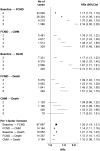Lifestyle, cardiometabolic disease, and multimorbidity in a prospective Chinese study
- PMID: 34333624
- PMCID: PMC8423468
- DOI: 10.1093/eurheartj/ehab413
Lifestyle, cardiometabolic disease, and multimorbidity in a prospective Chinese study
Abstract
Aims: The potential difference in the impacts of lifestyle factors (LFs) on progression from healthy to first cardiometabolic disease (FCMD), subsequently to cardiometabolic multimorbidity (CMM), and further to death is unclear.
Methods and results: We used data from the China Kadoorie Biobank of 461 047 adults aged 30-79 free of heart disease, stroke, and diabetes at baseline. Cardiometabolic multimorbidity was defined as the coexistence of two or three CMDs, including ischaemic heart disease (IHD), stroke, and type 2 diabetes (T2D). We used multi-state model to analyse the impacts of high-risk LFs (current smoking or quitting because of illness, current excessive alcohol drinking or quitting, poor diet, physical inactivity, and unhealthy body shape) on the progression of CMD. During a median follow-up of 11.2 years, 87 687 participants developed at least one CMD, 14 164 developed CMM, and 17 541 died afterwards. Five high-risk LFs played crucial but different roles in all transitions from healthy to FCMD, to CMM, and then to death. The hazard ratios (95% confidence intervals) per one-factor increase were 1.20 (1.19, 1.21) and 1.14 (1.11, 1.16) for transitions from healthy to FCMD, and from FCMD to CMM, and 1.21 (1.19, 1.23), 1.12 (1.10, 1.15), and 1.10 (1.06, 1.15) for mortality risk from healthy, FCMD, and CMM, respectively. When we further divided FCMDs into IHD, ischaemic stroke, haemorrhagic stroke, and T2D, we found that LFs played different roles in disease-specific transitions even within the same transition stage.
Conclusion: Assuming causality exists, our findings emphasize the significance of integrating comprehensive lifestyle interventions into both health management and CMD management.
Keywords: Cardiometabolic disease; Lifestyle; Multimorbidity; Progression; Prospective cohort study.
© The Author(s) 2021. Published by Oxford University Press on behalf of the European Society of Cardiology.
Figures





Comment in
-
Key roles of five lifestyle risk factors in the harmful transition from a healthy condition to multimorbidity in the Chinese population.Eur Heart J. 2021 Sep 7;42(34):3385-3387. doi: 10.1093/eurheartj/ehab516. Eur Heart J. 2021. PMID: 34355771 No abstract available.
References
-
- Academy of Medical Sciences. Multimorbidity: A Priority for Global Health Research. London: Academy of Medical Sciences; 2018.
-
- Busija L, Lim K, Szoeke C, Sanders KM, McCabe MP.. Do replicable profiles of multimorbidity exist? Systematic review and synthesis. Eur J Epidemiol 2019;34:1025–1053. - PubMed
-
- Kivimaki M, Kuosma E, Ferrie JE, Luukkonen R, Nyberg ST, Alfredsson L, Batty GD, Brunner EJ, Fransson E, Goldberg M, Knutsson A, Koskenvuo M, Nordin M, Oksanen T, Pentti J, Rugulies R, Shipley MJ, Singh-Manoux A, Steptoe A, Suominen SB, Theorell T, Vahtera J, Virtanen M, Westerholm P, Westerlund H, Zins M, Hamer M, Bell JA, Tabak AG, Jokela M.. Overweight, obesity, and risk of cardiometabolic multimorbidity: pooled analysis of individual-level data for 120 813 adults from 16 cohort studies from the USA and Europe. Lancet Public Health 2017;2:e277–e285. - PMC - PubMed
Publication types
MeSH terms
Grants and funding
LinkOut - more resources
Full Text Sources
Medical

